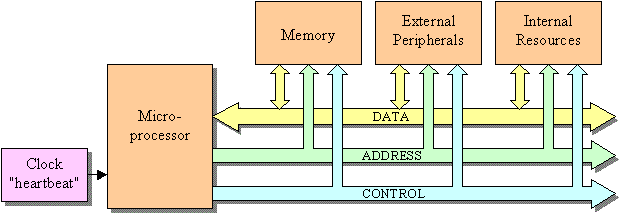
Microprocessor and Architecture: A Deep Dive into Modern Computing
The microprocessor, the heart of any modern computing device, executes instructions and performs calculations that drive our digital world. Understanding the intricacies of microprocessor and architecture is crucial for anyone involved in software development, hardware engineering, or even just trying to understand how their devices work. This article provides a comprehensive overview of microprocessor architecture, exploring its key components, functionalities, and evolution.
What is a Microprocessor?
A microprocessor is an integrated circuit (IC) that contains the central processing unit (CPU) functions. It fetches instructions from memory, decodes them, and executes them using its arithmetic logic unit (ALU), registers, and control circuits. The microprocessor is a programmable, clock-driven, register-based electronic device that accepts binary data as input, processes it according to instructions stored in its memory, and provides results as output.
Key Components of a Microprocessor Architecture
A microprocessor architecture comprises several key components that work together to execute instructions efficiently. These include:
- Arithmetic Logic Unit (ALU): Performs arithmetic and logical operations.
- Registers: Small, high-speed storage locations used to hold data and instructions that are being actively processed.
- Control Unit: Fetches instructions from memory and decodes them, controlling the execution of instructions by coordinating the other components.
- Cache Memory: Small, fast memory used to store frequently accessed data and instructions, improving performance.
- Buses: Sets of wires that transmit data, addresses, and control signals between different components.
Microprocessor Architecture Types
Different microprocessor architectures exist, each with its own strengths and weaknesses. The two primary types are:
Reduced Instruction Set Computing (RISC)
RISC architectures use a small set of simple instructions, each of which can be executed in a single clock cycle. This simplicity allows for faster execution speeds and lower power consumption. Examples of RISC processors include ARM processors commonly found in mobile devices and embedded systems. [See also: ARM Architecture: A Comprehensive Guide]
Complex Instruction Set Computing (CISC)
CISC architectures use a large set of complex instructions, which can perform multiple operations in a single instruction. This complexity can make programming easier, but it can also lead to slower execution speeds and higher power consumption. Intel x86 processors are a prime example of CISC architecture, widely used in desktop and laptop computers.
Evolution of Microprocessor Architecture
The microprocessor has undergone significant evolution since its invention in the early 1970s. Key milestones include:
- The First Microprocessor (Intel 4004): Introduced in 1971, it was a 4-bit processor with limited capabilities.
- 8-bit Microprocessors (Intel 8080, Zilog Z80): Enabled the development of early personal computers.
- 16-bit Microprocessors (Intel 8086, Motorola 68000): Offered increased processing power and memory addressing capabilities.
- 32-bit Microprocessors (Intel 80386, Motorola 68030): Became the standard for desktop computing, enabling multitasking and graphical user interfaces.
- 64-bit Microprocessors (AMD Athlon 64, Intel Pentium 4): Increased memory addressing capabilities and processing power, becoming the standard for modern computers and servers.
- Multi-Core Processors: Integrate multiple processing cores onto a single chip, allowing for parallel processing and improved performance.
Factors Influencing Microprocessor Performance
Several factors influence the performance of a microprocessor, including:
- Clock Speed: The rate at which the processor executes instructions, measured in Hertz (Hz).
- Cache Memory: The size and speed of the cache memory, which stores frequently accessed data and instructions.
- Number of Cores: The number of processing cores on the chip, which allows for parallel processing.
- Instruction Set Architecture: The type of instruction set used by the processor (RISC or CISC).
- Memory Bandwidth: The rate at which data can be transferred between the processor and memory.
Modern Trends in Microprocessor Architecture
The field of microprocessor architecture is constantly evolving, with several key trends shaping its future:
- Heterogeneous Computing: Integrating different types of processing units (e.g., CPUs, GPUs, FPGAs) onto a single chip to optimize performance for specific workloads.
- Power Efficiency: Reducing power consumption to extend battery life in mobile devices and reduce energy costs in data centers. [See also: Low-Power Microprocessor Design Techniques]
- Specialized Accelerators: Designing specialized hardware accelerators for specific tasks such as artificial intelligence (AI) and machine learning (ML).
- Chiplet Designs: Building microprocessors from smaller, modular chiplets that can be interconnected to create larger, more complex processors.
- Quantum Computing: Exploring the potential of quantum computers to solve problems that are intractable for classical computers.
The Role of Microprocessor Architecture in System Design
Microprocessor architecture plays a crucial role in the design of any computing system. The choice of microprocessor affects performance, power consumption, cost, and overall system capabilities. System designers must carefully consider these factors when selecting a microprocessor for a particular application.
For example, a mobile device requires a microprocessor with low power consumption and high performance, while a server requires a microprocessor with high processing power and reliability. Understanding the characteristics of different microprocessor architectures is essential for making informed design decisions.
Future Directions in Microprocessor Technology
The future of microprocessor technology is likely to be driven by several key factors, including:
- The End of Moore’s Law: The slowing down of transistor scaling, which has historically driven performance improvements.
- The Rise of AI and ML: The increasing demand for processing power to support AI and ML applications.
- The Internet of Things (IoT): The proliferation of connected devices, which require low-power, high-performance microprocessors.
- The Need for Security: The growing concern about security vulnerabilities in microprocessors.
These factors are likely to drive innovation in microprocessor architecture, leading to new designs and technologies that can address these challenges.
Conclusion
Microprocessor and architecture are fundamental concepts in computer science and engineering. Understanding the principles of microprocessor architecture is essential for anyone involved in the design, development, or use of computing systems. From the early days of the Intel 4004 to the multi-core processors of today, the microprocessor has revolutionized the way we live and work. As technology continues to evolve, the microprocessor will undoubtedly play an even more important role in shaping our future.
